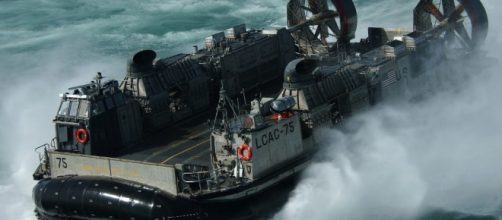The classic amphibious landing scenario involves a bombardment of a defended beach by Navy ships, followed by landing craft delivering infantry to the shore, fighting entrenched troops and, in the fullness of time, carving out a beachhead for follow-on waves to pour through. The battles of Normandy, Iwo Jima, and dozens of other actions in World War II featured forced entries by waves of infantry. Even 70 years ago these battles tended to be bloody almost beyond belief. Modern technology has made the classic beach invasion as obsolete as the cavalry charge.
According to Fox News, the United States Marines are developing the technology for a high-tech beach invasion, using “HyperSubs” and robots armed with Machine Guns and other weapons in the first wave.
The way a D-day of the 21st Century would work is that a group of vehicles called HyperSubs would be sent in first to perform reconnaissance of the beach defenses. These vehicles would be combination speedboats and submarines that would approach the shore ahead of the invasion fleet, scanning its defenses, providing needed intelligence for the forces to follow.
Bombardment of defended beaches, by the way, may involve ships using railguns hundreds of miles away, by the way. The beach would also be pasted with cruise missiles and other smart weapons.
The classic bombardment using ship-mounted guns may only happen toward the end of this phase.
The first wave of the invasion would consist of drone vehicles, low-slung amphibious craft with machine guns and other weapons mounted on them as were as aerial drones would hit the beach, clearing out defenses. These ground vehicles are called Multi-Utility Tactical Transports (MUTTs), Infantry may accompany these robot soldiers or, more likely, come in on the subsequent waves on board hovercraft and helicopters once the beach defenses have been cleared.
The Marines have already been testing these new robot soldiers at the Ship-to-Shore Maneuver Exploration and Experimentation Advanced Naval Technology Exercise 2017, in California.
The technology promises to change the way ground combat is waged as profoundly as when gunpowder weapons were introduced hundreds of years ago.
The most dangerous mission that a modern soldier can be assigned to is the clearing out of a fortified position, either on a defended beach or an urban area. The military is increasingly thinking of using robot soldiers for these hazardous missions, thus sparing the lives of human soldiers. Destroyed robots are not shipped home in flag draped coffins to their widows and orphans. Robots, either remote controlled or autonomous, can perform such missions with more precision, potentially mitigating what the military euphemistically call collateral damage.

